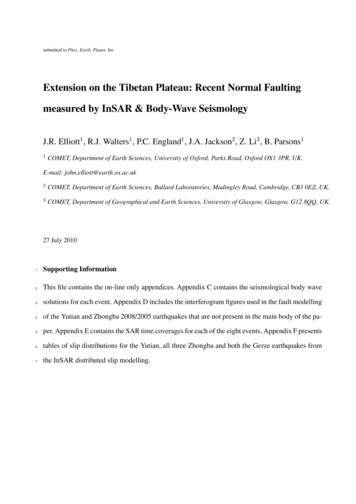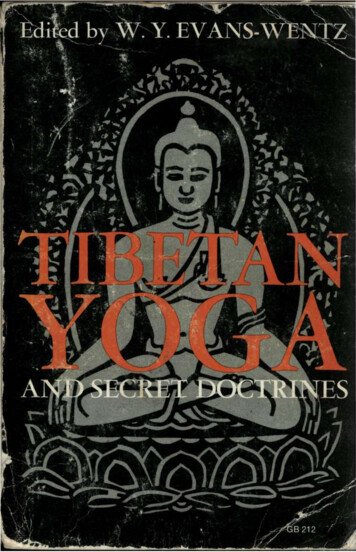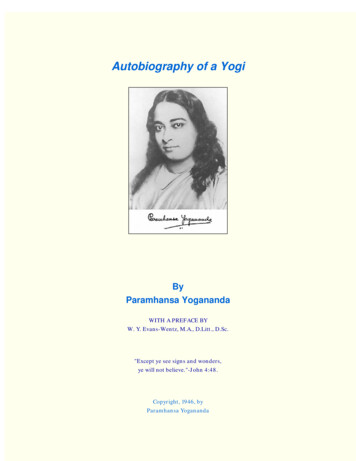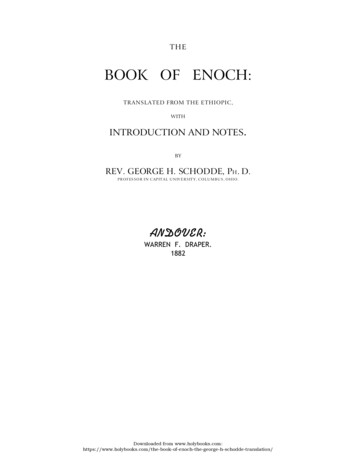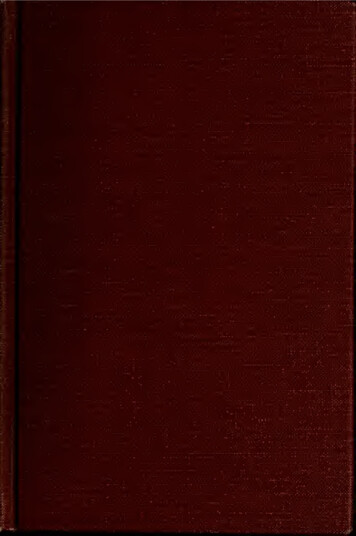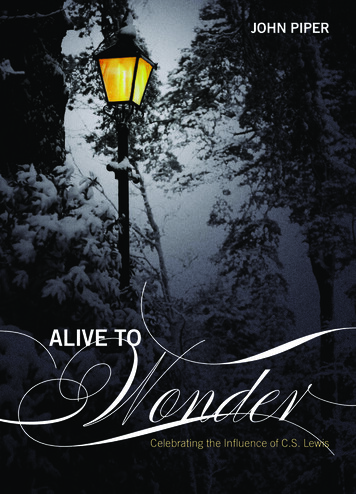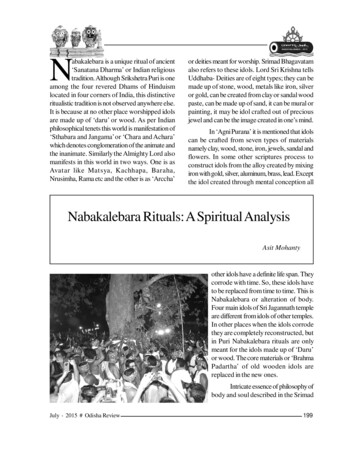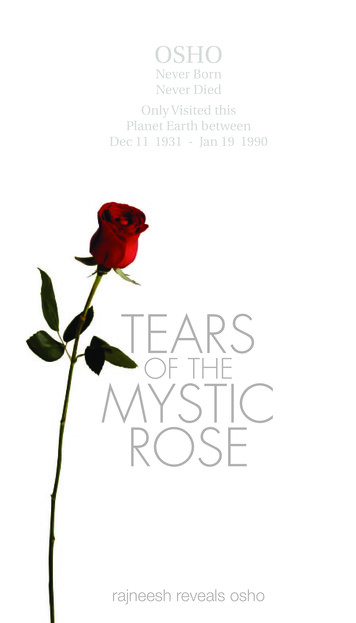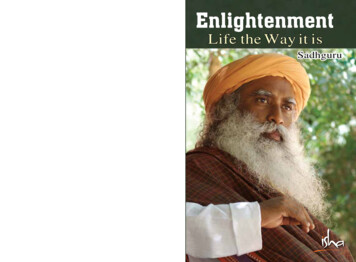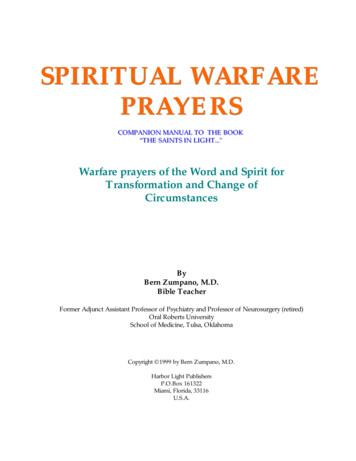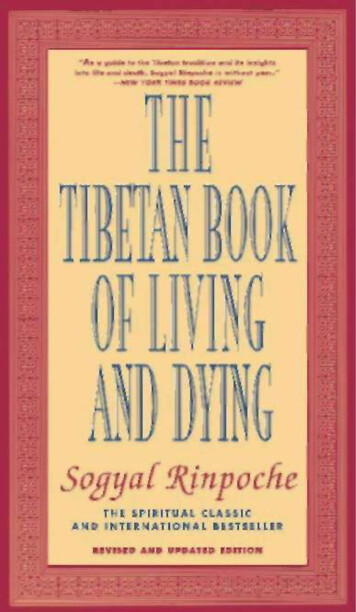
Transcription
The Tibetan Bookof Living and DyingSOGYAL RINPOCHERevised and UpdatedEdited byPATRICK GAFFNEY AND ANDREW HARVEY
I WOULD LIKE TO DEDICATE THIS BOOK TO Jamyang KhyentseChökyi Lodrö, Dudjom Rinpoche, Dilgo Khyentse Rinpoche, NyoshulKhen Rinpoche, Khyentse Sangyum Khandro TseringChödrön, and all my beloved masters, who have been the inspirationof my life.May this book be a guide to liberation, read by the living, and tothe dying, and for the dead.May it help all who read it and spur them on their journey toenlightenment!
ContentsDedicationForeword, by His Holiness the Dalai LamaIntroduction to the Revised Edition xiPreface xvixPART ONE: LIVING1.2.3.4.5.6.7.8.9.10.In the Mirror of Death 3Impermanence 15Reflection and Change 28The Nature of Mind 42Bringing the Mind Home 57Evolution, Karma, and Rebirth 86Bardos and Other Realities 106This Life: The Natural Bardo 115The Spiritual Path 131The Innermost Essence 154PART TWO: DYING11.12.13.14.15.Heart Advice on Helping the Dying 177Compassion: The Wish-Fulfilling Jewel 191Spiritual Help for the Dying 213The Practices for Dying 227The Process of Dying 248PART THREE: DEATH AND REBIRTH16.17.18.19.20.The Ground 263Intrinsic Radiance 278The Bardo of Becoming 291Helping After Death 303The Near-Death Experience: A Staircase toHeaven? 323vii
viiiCONTENTSPART FOUR: CONCLUSION21. The Universal Process 34322. Servants of Peace 360AppendixAppendixAppendixAppendix1: My Teachers 3712: Questions About Death3: Two Stories 3854: Two Mantras 393Notes 399Selected Bibliography 415Acknowledgments 419Index 425About the AuthorCreditsCoverCopyrightAbout the Publisher378
Forewordby His Holiness the Dalai LamaIN THIS TIMELY BOOK, Sogyal Rinpoche focuses onhow to understand the true meaning of life, how to acceptdeath, and how to help the dying, and the dead.Death is a natural part of life, which we will all surely haveto face sooner or later. To my mind, there are two ways wecan deal with it while we are alive. We can either choose toignore it or we can confront the prospect of our own deathand, by thinking clearly about it, try to minimize the sufferingthat it can bring. However, in neither of these ways can weactually overcome it.As a Buddhist, I view death as a normal process, a realitythat I accept will occur as long as I remain in this earthly existence. Knowing that I cannot escape it, I see no point in worrying about it. I tend to think of death as being like changingyour clothes when they are old and worn out, rather than assome final end. Yet death is unpredictable: We do not knowwhen or how it will take place. So it is only sensible to takecertain precautions before it actually happens.Naturally, most of us would like to die a peaceful death,but it is also clear that we cannot hope to die peacefully if ourlives have been full of violence, or if our minds have mostlybeen agitated by emotions like anger, attachment, or fear. So ifwe wish to die well, we must learn how to live well: Hopingfor a peaceful death, we must cultivate peace in our mind, andin our way of life.As you will read here, from the Buddhist point of view, theactual experience of death is very important. Although how orwhere we will be reborn is generally dependent on karmicforces, our state of mind at the time of death can influence thequality of our next rebirth. So at the moment of death, inspite of the great variety of karmas we have accumulated, ifwe make a special effort to generate a virtuous state of mind,we may strengthen and activate a virtuous karma, and sobring about a happy rebirth.ix
XFOREWORDThe actual point of death is also when the most profoundand beneficial inner experiences can come about Throughrepeated acquaintance with the processes of death in meditation, an accomplished meditator can use his or her actual deathto gain great spiritual realization. This is why experienced practitioners engage in meditative practices as they pass away Anindication of their attainment is that often their bodies do notbegin to decay until long after they are clinically dead.No less significant than preparing for our own death ishelping others to die well. As a newborn baby each of us washelpless and, without the care and kindness we received then,we would not have survived. Because the dying also areunable to help themselves, we should relieve them of discomfort and anxiety, and assist them, as far as we can, to die withcomposure.Here the most important point is to avoid anything whichwill cause the dying person's mind to become more disturbedthan it may already be. Our prime aim in helping a dying person is to put them at ease, and there are many ways of doingthis. A dying person who is familiar with spiritual practicemay be encouraged and inspired if they are reminded of it,but even kindly reassurance on our part can engender a peaceful, relaxed attitude in the dying person's mind.Death and Dying provide a meeting point between theTibetan Buddhist and modern scientific traditions. I believeboth have a great deal to contribute to each other on the levelof understanding and of practical benefit. Sogyal Rinpoche isespecially well placed to facilitate this meeting; having beenborn and brought up in the Tibetan tradition, he has receivedinstructions from some of our greatest Lamas. Having alsobenefitted from a moden education and lived and worked asa teacher for many years in the West, he has become wellacquainted with Western ways of thought.This book offers readers not just a theoretical account ofdeath and dying, but also practical measures for understanding,and for preparing themselves and others in a calm and fulfilling way.June 2, 1992The Dalai Lama
Introduction to the Revised EditionIT IS N O W TEN YEARS SINCE The Tibetan Book of Living and Dying was first published. In this book, I endeavoredto share something of the wisdom of the tradition I grew upin. I sought to show the practical nature of its ancient teachings, and the ways in which they can help us at every stage ofliving and dying. Many people, over the years, had urged meto write this book. They said that it would help relieve someof the intense suffering that so many of us go through in themodern world. As His Holiness the Dalai Lama has pointedout, we are living in a society in which people find it harderand harder to show one another basic affection, and whereany inner dimension to life is almost entirely overlooked. It isno wonder that there is today such a tremendous thirst for thecompassion and wisdom that spiritual teachings can offer.It must have been as a reflection of this need that TheTibetan Book of Living and Dying was received with such enthusiasm around the world. At first I was astonished: I had neverexpected it to have such an impact, especially since at thetime of writing this book, death was still very much a subjectthat was shunned and ignored. Gradually, as I traveled to different countries, teaching and leading workshops and trainingsbased on the teachings in this book, I discovered the extent towhich it had struck a chord in people's hearts. More and moreindividuals came up to me or wrote to tell me how theseteachings had helped them through a crisis in their lives orsupported them through the death of a loved one. And eventhough the teachings it contains may be unfamiliar, there arethose who have told me they have read this book severaltimes and keep returning to it as a source of inspiration. Afterreading The Tibetan Book of Living and Dying, a woman inMadras in India was so inspired that she founded a medicaltrust, with a hospice and palliative care center. Another personxt
xiiINTRODUCTIONin the United States came to me and said she was baffled byhow a mere book could have, in her words, "loved her socompletely." Stories like these, so moving and so personal, testify to the power and relevance of the Buddhist teachingstoday. Whenever I hear them, my heart fills with gratitude,both to the teachings themselves and to the teachers and practitioners who have undergone so much in order to embodythem and hand them on.In time, I came to learn that The Tibetan Book of Living andDying had been adopted by institutions, centers, and groups ofvarious kinds, educational, medical, and spiritual. Nurses, doctors, and those professionally involved with care for the dyinghave told me how they have integrated these methods in theirdaily work, and I have heard many accounts of ordinary peopleusing these practices and finding that they transformed thedeath of a friend or close relative. Something I find especiallymoving is that this book has been read by people with different spiritual beliefs, and they have said that it has strengthened and deepened their faith in their own tradition. Theyseem to recognize the universality of its message, and understand that it aims not to persuade or convert, but simply tooffer the wisdom of the ancient Buddhist teachings in order tobring the maximum possible benefit.As The Tibetan Book of Living and Dying quietly took on alife of its own, moving inconspicuously through manydomains and disciplines, I began to understand the ultimatesource of its great influence and appeal. These extraordinaryteachings are the heart essence of the oral lineage, that unbroken line of wisdom passed down as a living experience overthe centuries. Someone once called this book "midwaybetween a living master and a book," and it is true that bothin The Tibetan Book of Living and Dying and behind it, supporting it with their advice and answers to questions, are thegreatest masters of our time. It is their voice that speaksthrough these pages, their wisdom and their vision of a compassionate world infused by the knowledge of our true nature,the innermost nature of mind. The impact of The Tibetan Bookof Living and Dying, I believe, is due to the blessing of the lineage and the vibrancy of the oral tradition. Its popularity hasbeen a humbling experience for me, and it has reminded methat if I have any ability to communicate these teachings, it isonly because of the devotion inspired in me by the teachingsand the kindness of my masters, and nothing else.Over these last ten years there have been many changes in
INTRODUCTIONxiiiour attitudes toward death and in the kind of care we as asociety offer to the dying and the bereaved. Public awarenessof death and the many issues surrounding dying has beenheightened. Books, Web sites, conferences, serious radio andtelevision series, films, and support groups have all contributedto a greater openness toward looking into death. There hasbeen a considerable expansion in hospice work and palliativecare, and this has been the period during which, in somecountries, the whole field of care for the dying has beenopened up. Initiatives of many kinds have taken place,inspired by courageous men and women, for whom I havethe greatest respect and admiration. Meanwhile, there havebeen more and more requests for those working in the Buddhist tradition to take part in projects and explore how theycan contribute.A number of my friends and students have gradually created an international program of education and training basedon the teachings in this book and designed to offer spiritualcare to the dying, their families, and those who care for them.We offer courses for the medical profession and the public,coordinate volunteers, and have begun to work hand in handwith hospitals, clinics, hospices, and universities. What isencouraging is that there is a growing recognition everywherethat spiritual issues are central to the care of the dying, and insome countries a number of medical schools now offercourses in spirituality and medicine. Yet, I am told, surveysshow that denial of death still prevails, and we are still lackingin our ability to offer spiritual help and care for the dying andanswer their deepest needs. The kind of death we have is soimportant. Death is the most crucial moment of our lives, andeach and every one of us should be able to die in peace andfulfillment, knowing that we will be surrounded by the best inspiritual care.If The Tibetan Book of Living and Dying has played somesmall part in helping us look at how we deal with our owndeath and that of those around us, it is an answer to myprayers, and I am deeply moved and grateful. It is still mydream that the teachings presented here be made available topeople everywhere, of all ages, and at all levels of education.My original hope for this book was that it would help inspirea quiet revolution in the whole way we look at death andcare for the dying, and so the whole way we look at life andcare for the living. Our need for spiritual transformation and totake responsibility, in the truest sense, for ourselves and others
xivINTRODUCTIONhas not become any less urgent these ten years on. Whatwould it mean if more and more people thought seriouslyabout their future and the future of the world? Imagine howthings would be if we could live our lives infusing them witha sacred meaning; if our end-of-life care were always lit by asense of awe in the face of death; and if we looked on lifeand death themselves as an inseparable whole. What wouldbe the effect of seeking to make love and compassion themeasure of our every action, and of understanding, to anydegree, the inmost nature of the mind that underlies our entireexistence? This would be a true revolution, one that wouldfree men and women to discover their birthright, that innerdimension so long neglected, and unite them with the fullnessof the human experience in all its mystery and grandeur.Sogyal RinpocheLerab Ling, FranceNovember 2001
PrefaceI WAS BORN IN TIBET, and I was six monthsold when I entered the monastery of my master JamyangKhyentse Chökyi Lodrö, in the province of Kham. In Tibet wehave a unique tradition of finding the reincarnations of greatmasters who have passed away. They are chosen young andgiven a special education to train them to become the teachersof the futur
Tibetan Book of Living and Dying was received with such enthu siasm around the world. At first I was astonished: I had never expected it to have such an impact, especially since at the time of writing this book, death was still very much a subject that was shunned and ignored. Gradually, as I traveled to dif ferent countries, teaching and leading workshops and trainings based on the .
